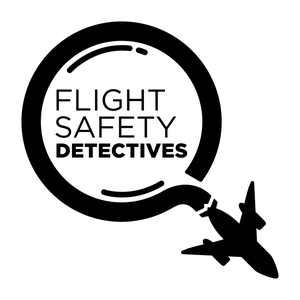
Flight Safety Detectives
flightsafetydetectives
John and Greg are two of the world's most respected aviation experts. Greg was inducted into the Living Legends of Aviation. John is the only airframe and powerplant mechanic to receive a presidential appointment to the NTSB.
- 33 minutes 48 secondsDale Earnhardt Jr Survives Air Crash Caused by Bad Pilot Decisions - Episode 255
NASCAR driver Dale Earnhardt Jr. and his family survived the August 15, 2019 crash of a Cessna Citation Latitude jet caused by bad pilot decisions. John Goglia, Greg Feith and Todd Curtis go beyond the NTSB report to explore what led to an “unstabilized, ridiculously fast” landing that destroyed the aircraft.
Both crew members had hundreds of hours of flight experience in this aircraft model, and the copilot was also the director of operations for the airplane operator. In spite of their experience, the crew decided to continue the approach after realizing the aircraft was in an unstabilized approach.
The aircraft landed too fast, was not configured properly for landing, and bounced several times before one of the main landing gear collapsed. The plane then departed the runway, came to rest just outside the airport, and caught fire. Fortunately, everyone was able to escape.
The detectives explore several factors:- Lack of planning by the flight crew
- Use of nonstandard procedures to salvage an unstabilized approach
- Answers missing in the NTSB analysis of the accident.
This accident is similar to a 2004 event involving a Gulfstream jet headed to Houston to pick up former president George H.W. Bush. Like the crash with Dale Earnhardt Jr, the experienced crew found themselves in an unstabilized approach, failed to follow standard procedures, and crashed.
Don’t miss what’s to come from the Flight Safety Detectives - subscribe to the Flight Safety Detectives YouTube channel, listen at your favorite podcast service and visit the Flight Safety Detectives website.
Music: “Inspirational Sports” license ASLC-22B89B29-052322DDB8
29 January 2025, 11:00 am - 36 minutes 32 secondsLax Maintenance Practices Kills 2 in Cessna Crash - Episode 254
Lax oversight by the FAA and questionable maintenance practices by both a flight school and the previous owner of a Cessna 172P aircraft led to a fatal plane crash. The Flight Safety Detectives find this is another aviation disaster that could have been avoided.
The NTSB report points to a corroded aileron control cable that failed just after takeoff as the cause of the event. Todd Curtis, Greg Feith, and John Goglia discuss the circumstances that led to the crash, killing a student and an instructor.
The aircraft involved had been sitting idle for about a year before a flight school purchased it. The original maintenance manual had been lost, and a partial maintenance record was provided to the new owner.
Incomplete maintenance logbooks should have prompted a reasonable potential owner to conduct an extensive inspection to uncover issues with the aircraft, yet none was done. The NTSB report does not mention any efforts taken to find maintenance-related records at FAA or elsewhere, actions that would have been reasonable.
A pre-buy inspection was done less than a month before the accident. Although some issues were noted, the inspection failed to identify extensive aileron cable corrosion.
Don’t miss what’s to come from the Flight Safety Detectives - subscribe to the Flight Safety Detectives YouTube channel, listen at your favorite podcast service and visit the Flight Safety Detectives website.
Music: “Inspirational Sports” license ASLC-22B89B29-052322DDB8
22 January 2025, 10:00 am - 25 minutes 3 secondsLA Firefighting Aircraft Grounded by Illegal Drone Activity - Episode 253
A midair collision between a private drone and an aircraft fighting the Los Angeles area fires caused damage to the plane and an evacuation of all firefighting aircraft from the area. John Goglia and Todd Curtis explore the tragic effect on firefighting as well as the violations of aviation rules.
This event was a major setback in firefighting efforts. The FAA had taken steps to restrict flying around the fire area that were not followed. They expect federal action to be taken against the drone pilot.
The collision with the DJI Mini 4 Pro drone punched a hole in the leading edge of the left wing and grounded the Canadair CL-415 SuperScooper amphibious aircraft for several days. The FBI recovered the drone wreckage from inside the wing and is looking for the pilot.
The Canadair SuperScooper amphibious aircraft is designed to pick up about 1,600 gallons of water from lakes or oceans and drop it on large fires. It was one of the largest aircraft types operating over the fires in California.
Most drone operators have no certification and are unaware of the FAA regulations restricting where and when drones can fly. Todd and John highlight the basics. Drone operators must educate themselves on FAA regulations and follow the rules.
Don’t miss what’s to come from the Flight Safety Detectives - subscribe to the Flight Safety Detectives YouTube channel, listen at your favorite podcast service and visit the Flight Safety Detectives website.
Music: “Inspirational Sports” license ASLC-22B89B29-052322DDB8
15 January 2025, 10:00 am - 42 minutes 48 secondsHair-Raising UAP Encounter Shared by Pilot - Episode 252
Sailplane pilot Bob Pett had a close encounter with an unidentified aerial phenomenon (UAP) that exhibited extraordinary speed and maneuverability. Bob shares the experience with John Goglia and Todd Curtis in his first public statement about the encounter.
While the first UAP flew in close formation off his left wing during the encounter, two similar UAPs descended from a cloud and joined up with the first. Seeing the next two UAPs approach raised the hair on the back of Bob’s neck.
Bob and his passenger documented what they saw on August 9, 2015, including sketches of the event. Richard Haines of the National Aviation Reporting Center on Anomalous Phenomena (NARCAP) later published a detailed report of the encounter. Bob was not identified by name in the report.
Several aspects of this encounter, including pilot decision-making under stress, reporting hazardous events to the appropriate authorities, and the lingering effects of experiencing a potentially catastrophic event in the air, are relevant to aviation safety with or without the involvement of a UAP.
The aviation industry has not taken the UAP issue seriously. Despite the increased acceptance of the issue at the highest level of government, resistance to discussing the issue remains.
UAP-related aviation safety issues should be reported by pilots, mechanics, flight attendants, other aviation professionals, and passengers. NASA's Aviation Safety Reporting System (ASRS) is an excellent and anonymous reporting system that ensures that anyone reporting a UAP event will not be identified.
Don’t miss what’s to come from the Flight Safety Detectives - subscribe to the Flight Safety Detectives YouTube channel, listen at your favorite podcast service and visit the Flight Safety Detectives website.
Music: “Inspirational Sports” license ASLC-22B89B29-052322DDB8
10 January 2025, 11:00 am - 26 minutes 1 secondAttack of the Drones? - Episode 251
A wave of drone sightings are being reported throughout New Jersey and metropolitan New York, including flights over military installations and critical infrastructure. Drones are now part of battlefields. Are we under attack?
Todd Curtis and John Goglia look at the facts of the recent drone sightings. Some video clearly shows airplanes in flight. However, others appear to show drones.
The federal government's response has been lacking, with government spokespersons offering few insights into who or what is behind the drone flights or whether there is a national security issue.
Russia, China, Iran or private companies testing advanced technology are not likely behind the drone flights since being caught performing such flights would not be in their best interests. There also does not seem to be any attempt to hide the activity.
Todd shares the FAA requirements for drone flights at night, including use of remote ID.
The government has added dozens of flight restrictions in New Jersey and New York. These may not be effective because there may not be enough resources in place to identify drone activity in all those areas.
Todd and John discuss their work as instructors at Vaughn College in New York, describing how the students there create drones using 3-D printing. Todd, a commercial drone pilot since 2016, discusses the drone class he teaches and how he incorporates drone developments, such as the innovations in the use of drones in the war in Ukraine, into the course.
More to come on drones as Todd and John examine a sailplane encounter with a UAP in the next episode.
Don’t miss what’s to come from the Flight Safety Detectives - subscribe to the Flight Safety Detectives YouTube channel, listen at your favorite podcast service and visit the Flight Safety Detectives website.
Music: “Inspirational Sports” license ASLC-22B89B29-052322DDB8
8 January 2025, 11:00 am - 22 minutes 40 secondsRicky Nelson Plane Crash - What Caused the Fire? - Episode 250
Fire and smoke led to the crash of a Douglas DC3 that killed signer Ricky Nelson and six others. To this day, rumors surround this 1985 deadly crash. Todd Curtis and John Goglia dig in to analyze the known facts.
Among the rumors they explore is one that suggests that Ricky Nelson and other passengers may have caused a fire while using drugs in the passenger cabin. Although the NTSB report was inconclusive about the cause of the fire, the crew had reported issues starting the cabin heating system.
For John, this aviation disaster illustrates his larger concern about maintenance and operation of charter aircraft. He feels strongly that anyone who charters aircraft should check out the potential supplier of services to ensure they follow FAA requirements for operating their aircraft.
Don’t miss what’s to come from the Flight Safety Detectives - subscribe to the Flight Safety Detectives YouTube channel, listen at your favorite podcast service and visit the Flight Safety Detectives website.
Music: “Inspirational Sports” license ASLC-22B89B29-052322DDB8
18 December 2024, 2:40 pm - 30 minutes 59 secondsIs It Safe to Fly Qantas? - Episode 249
Is Qantas Airlines safe? Two recent events have led the Australian media and others to raise that question.
The first safety issue was in November 2024. A tool was left in the engine of a Qantas A380 for nearly a month before it was discovered. A few days later, a Qantas 737 had an engine failure while taking off from Sydney.
The Australian media covered these events extensively, raising concerns about Qantas’ safety. The Flight Safety Detectives look at whether these events establish a pattern of concern.
One factor here is that the Australian Transport Safety Bureau (ATSB) investigates events that would likely not generate a detailed report if they happened on an aircraft registered in the U.S. or elsewhere.
John Goglia and Todd Curtis also discuss a 2020 fuel dumping event over Los Angeles that resulted in many school children being exposed to fuel. The FAA issued a report that stated that fuel dumping is relatively rare in the U.S., averaging about 15 events per year from 2015 to 2020. Hear how and why these events occur.Don’t miss what’s to come from the Flight Safety Detectives - subscribe to the Flight Safety Detectives YouTube channel, listen at your favorite podcast service and visit the Flight Safety Detectives website.
Music: “Inspirational Sports” license ASLC-22B89B29-052322DDB8
11 December 2024, 10:00 am - 37 minutes 20 secondsFirst Fatality Involving HondaJet - Episode 247
The first fatal HondaJet accident just occurred. Greg Feith and John Goglia go over the known facts of the air crash in Mesa, Arizona on November 5.
The jet ran off the runway and struck a car on a nearby road, killing the driver and four of the five people on board the jet. They draw similarities with a 2014 takeoff accident involving a Gulfstream jet near Boston.
Poor preflight preparation may be the biggest contributor to this deadly event. Greg and John share the simple tests and steps that can be the difference between a successful and a fatal flight.
Greg and John also discuss Greg's recent recognition from the National Aeronautic Association. Greg was named a 2023 Distinguished Statesmen of Aviation.
Greg and John finished the episode with a discussion of the show's newest advertiser, Piston Power, and how their various options for managing routine and non-routine repairs may benefit an aircraft owner.
They also welcome a new sponsor - PistonPower™. The company offers general aviation’s first and only Unscheduled and Power-by-the-Hour programs for piston aircraft. Designed by aviation pros who’ve designed and built similar programs for turbine engines, PistonPower™ brings stability to your maintenance budget and peace of mind to your business and personal flying.
No Risk. No Surprises. Stabilize Your Maintenance Budget!
Don’t miss what’s to come from the Flight Safety Detectives - subscribe to the Flight Safety Detectives YouTube channel, listen at your favorite podcast service and visit the Flight Safety Detectives website.
Music: “Inspirational Sports” license ASLC-22B89B29-052322DDB8
20 November 2024, 4:39 pm - 27 minutes 7 secondsU.S. Army UH-1 Huey Helicopter Crash Kills 6- Episode 246
A U.S. Army UH-1 Huey helicopter survived the perils of Vietnam but came to a disastrous end in West Virginia. The 1962 helicopter crashed after its engine failed, killing the pilot and five passengers.
The 2022 crash happened during an annual event that offers visitors an opportunity to fly either as passengers or as a second pilot. This helicopter was a warbird--a former military aircraft operating as a civil aircraft. It was operated under a special airworthiness certificate in the experimental category.
Although the pilot in command had flown this same helicopter at the annual event in the previous two years, he had logged only 21 hours of flying experience in that helicopter. One of the five passengers was a helicopter pilot who had paid to operate the helicopter during the flight.About 15 minutes into the flight, the engine failed. The helicopter struck power lines and a rock face before crashing and catching fire. The NTSB could not determine if the pilot in command or the helicopter-rated passenger attempted the emergency landing.
Despite the number of people killed in warbird crashes, it is unlikely the FAA will make major changes in how it oversees operators of these types of flights because of the relatively small number of operators. John and Todd share thoughts on what these operators can do to ensure safety.Don’t miss what’s to come from the Flight Safety Detectives - subscribe to the Flight Safety Detectives YouTube channel, listen at your favorite podcast service and visit the Flight Safety Detectives website.
Music: “Inspirational Sports” license ASLC-22B89B29-052322DDB8
13 November 2024, 11:00 am - 22 minutes 36 secondsDrone Accident and A First for the National Aviation Hall of Fame- Episode 245
Flight Safety Detectives host John Goglia will be inducted into the National Aviation Hall of Fame, a rare accomplishment in aviation. John is the first person whose career was focused on aviation maintenance to be selected. John Goglia and Todd Curtis talk about the honor before diving into a recent drone accident in Boston that injured two people.
The drone crash occurred in downtown Boston during the taping of the TNT show "Inside the NBA." The drone crashed into a pole and fell, injuring people in the crowd. The drone flight would likely have had a FAA exemption to allow a flight both near crowds of people and close to Boston's Logan Airport.
Todd and John also discuss John's recent visit to the NBAA (National Business Aviation Association) exhibition in Las Vegas. John saw many of the companies and technologies behind the vertical takeoff and landing aircraft associated with advanced air mobility (AAM) companies like Joby. The FAA has just released regulations related to the commercial use of such aircraft.
Todd and John talk about the potential for AAM operations in the U.S. They discuss several possible issues might slow adoption.Don’t miss what’s to come from the Flight Safety Detectives - subscribe to the Flight Safety Detectives YouTube channel, listen at your favorite podcast service and visit the Flight Safety Detectives website.
Music: “Inspirational Sports” license ASLC-22B89B29-052322DDB8
6 November 2024, 11:00 am - 32 minutes 53 secondsBad Fuel Line Causes Engine Fire & Crash - Episode 244
A fatal Piper PA-28-300 plane crash was caused by a loose fuel line that should never have been installed on the aircraft. The NTSB investigation of the fatal May 2018 crash shows that a fuel line that was not approved for use on that aircraft led to an engine fire.
Todd Curtis and John Goglia examine the details. Although the fuel line used was an approved aviation part, it was not approved for use in this aircraft. The NTSB could not determine who installed the part or when it was installed.
Approved parts used in unapproved ways is an ongoing issue in aviation. Some individuals in the general aviation community even promote the use of auto parts instead of more expensive approved aviation parts.
John, who worked on FAA committees on the issue of unapproved parts in the 1980s, has seen many unapproved part issues with several major airlines. The FAA began requiring more documentation for aircraft parts in the 1990s, but the problem persists.
The accident pilot was aware that the engine had issues. Before the flight, the pilot told a CFI that he would perform an engine runup and take off only if the runup was successful.
This accident involved pilot decision-making under uncertainty concerning whether to take off with an engine problem. This kind of issue happens at all levels of aviation. The fatal crash of an Alaska Airlines MD83 in 2000 is just another example.
Don’t miss what’s to come from the Flight Safety Detectives - subscribe to the Flight Safety Detectives YouTube channel, listen at your favorite podcast service and visit the Flight Safety Detectives website.
Music: “Inspirational Sports” license ASLC-22B89B29-052322DDB8
30 October 2024, 10:00 am - More Episodes? Get the App
Your feedback is valuable to us. Should you encounter any bugs, glitches, lack of functionality or other problems, please email us on [email protected] or join Moon.FM Telegram Group where you can talk directly to the dev team who are happy to answer any queries.
 Aviation News Talk podcast
Aviation News Talk podcast
 "There I was..." An Aviation Podcast
"There I was..." An Aviation Podcast
 Opposing Bases: Air Traffic Talk
Opposing Bases: Air Traffic Talk
 Take to the Sky: the Air Disaster Podcast
Take to the Sky: the Air Disaster Podcast
 Airplane Geeks Podcast
Airplane Geeks Podcast
 AOPA Never Again
AOPA Never Again